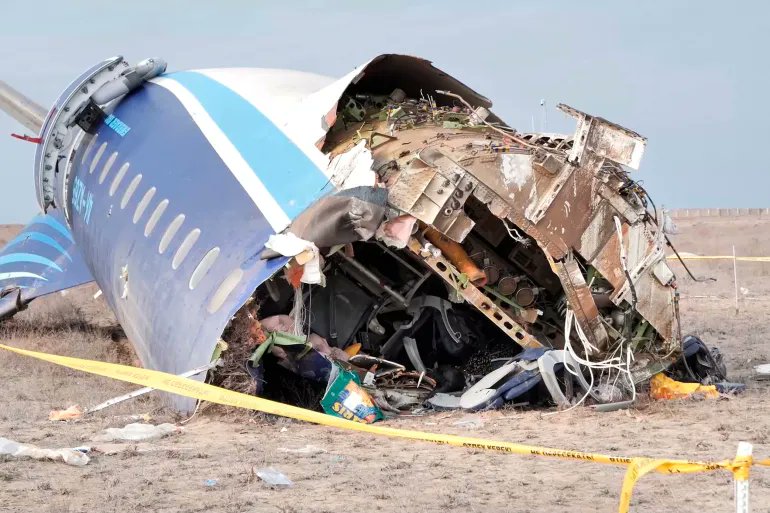By Adeyemi Adekunle
A tragic plane crash near the Kazakh city of Aktau on December 25 has left 38 people dead and 29 injured, prompting widespread grief and mounting speculation over its cause. Experts now suggest that Russian air defense fire, potentially aimed at intercepting a Ukrainian drone, may have inadvertently brought down the Azerbaijan Airlines Embraer 190.
The ill-fated flight was en route from Azerbaijan’s capital, Baku, to Grozny, the capital of Russia’s Chechen Republic, when it was diverted under unclear circumstances. Instead of landing in Grozny, the plane flew hundreds of miles east over the Caspian Sea before attempting to land in Aktau. It crashed three kilometers short of the runway, exploding in a fiery wreck captured on cellphone footage shared online.
Images of the crash site reveal a plane torn apart, with its fuselage shattered and the tail section showing signs of significant damage. Aviation and military experts have pointed to this evidence as a potential indication of an external strike, most likely from a surface-to-air missile (SAM).
Mark Zee, from OPSGroup, which monitors global airspace risks, stated that the likelihood of a SAM attack was “well into the 90 to 99% bracket.” Similarly, Yan Matveyev, an independent Russian military analyst, highlighted damage to the tail consistent with shrapnel from missiles used in Russia’s Pantsyr-S1 air defense system. The system has been widely deployed to counter escalating drone attacks on Russian territory amid the ongoing conflict with Ukraine.
Russia’s civil aviation authority, Rosaviatsia, initially attributed the plane’s diversion to a bird strike, which reportedly caused an onboard emergency. However, this explanation has been met with skepticism as details surrounding the crash continue to emerge.
Azerbaijani news outlet Caliber, known for its ties to the government, claimed that the airliner was struck by Russian air defenses as it approached Grozny, where a Ukrainian drone attack was reportedly underway at the time. The outlet further questioned why the Grozny airport was not closed during the drone raid and why the plane was not permitted to make an emergency landing at a closer Russian airport.
The Kremlin has dismissed the speculation as premature. Spokesperson Dmitry Peskov urged against drawing conclusions before an official investigation is completed. Meanwhile, Kazakhstan’s parliamentary speaker, Maulen Ashimbayev, echoed similar sentiments, warning that baseless allegations could hinder the investigation.
The human toll of the crash has left the region in mourning. In Azerbaijan, flags flew at half-mast, and a nationwide moment of silence was observed. Ships and trains halted at noon, their signals sounding a somber tribute to the victims.
The passengers included 42 Azerbaijani citizens, 16 Russians, six Kazakhs, and three Kyrgyz nationals. Nine Russian survivors were flown to Moscow on Thursday for treatment by Russia’s Emergencies Ministry.
As investigators from Kazakhstan, Azerbaijan, and Russia collaborate to determine the cause of the crash, the tragedy has drawn attention to the increasingly fraught skies over the region. Ongoing drone warfare has heightened risks for civilian aviation, with experts like Andrew Nicholson, CEO of Osprey Flight Solutions, emphasizing the need for greater vigilance.
Nicholson noted that his firm had issued over 200 warnings about the hazards posed by air defense systems in Russia since the start of the conflict with Ukraine. “This incident is a stark reminder of why we do what we do,” he said, lamenting the preventable loss of life.
The diverted flight’s route and ultimate destination remain key points of inquiry. Analysts have speculated that the plane’s crew may have attempted to reach Aktau after sustaining damage mid-air, believing they could still land safely. However, questions linger about why an emergency landing at closer Russian airports was not pursued.
Amidst families mourning their loved ones, calls for accountability are growing louder. Yet, with geopolitical tensions running high, it remains uncertain whether the investigation will yield clarity or be clouded by competing narratives.




